If you’ve ever been torn between craving a flaky croissant and a chewy sourdough, this croissant sourdough loaf recipe gives you the best of both worlds. We’re diving into how to bring those dreamy layers and tangy crumb together in one irresistible bake. Whether it’s for a brunch table or just a treat-yourself moment on a quiet Sunday, this loaf is pure joy. You’ll get a relatable story, step-by-step guidance, and tips for nailing this croissant sourdough loaf recipe at home—no pastry degree required.

A Comforting Story Behind the Croissant Sourdough Loaf Recipe
- When a Regular Loaf Just Doesn’t Cut It
I still remember the weekend I first tried this croissant sourdough loaf recipe. It was chilly outside, and I had some butter left from making chocolate tahini bites the day before. Instead of sticking to my go-to sourdough, I decided to laminate the dough on a whim—grating cold butter over the surface like I’d seen in croissant tutorials. Honestly, I didn’t expect much. But when the loaf came out of the oven golden, puffy, and smelling like heaven, I knew I had something special. - One Bite Was All It Took
The crust had those classic sourdough bubbles, but when I sliced in, buttery flakes spilled out like a pastry. I spread on some jam from my fridge and took a bite—it was everything. Tangy. Rich. Just enough crunch. The balance of sourdough chew and croissant softness was unlike anything I’d baked before. Since then, I’ve added it to my weekend lineup, right next to cozy staples like pimento cheese stuffed pretzel bites and my favorite banana breads. - Why This Recipe Is a Keeper
Making a croissant sourdough loaf recipe isn’t about perfection—it’s about layering care into your dough. Using an active sourdough starter and cold butter is key. The stretch and folds build structure, while laminating with butter gives you that pastry-style flake. It takes time, but the payoff is worth it. Plus, the loaf stores beautifully and makes a terrific gift (if you can bear to part with it). - It’s More Than Just Bread
When people ask if this croissant sourdough loaf recipe is hard, I tell them it’s like a gentle kitchen experiment. You’ll learn to feel the dough, trust the process, and enjoy the smell that fills your kitchen. It’s not just bread. It’s a memory-maker. And once you try it, you’ll never want to go back to plain sourdough again.
Table of Contents
How to Build the Dough for a Croissant Sourdough Loaf Recipe
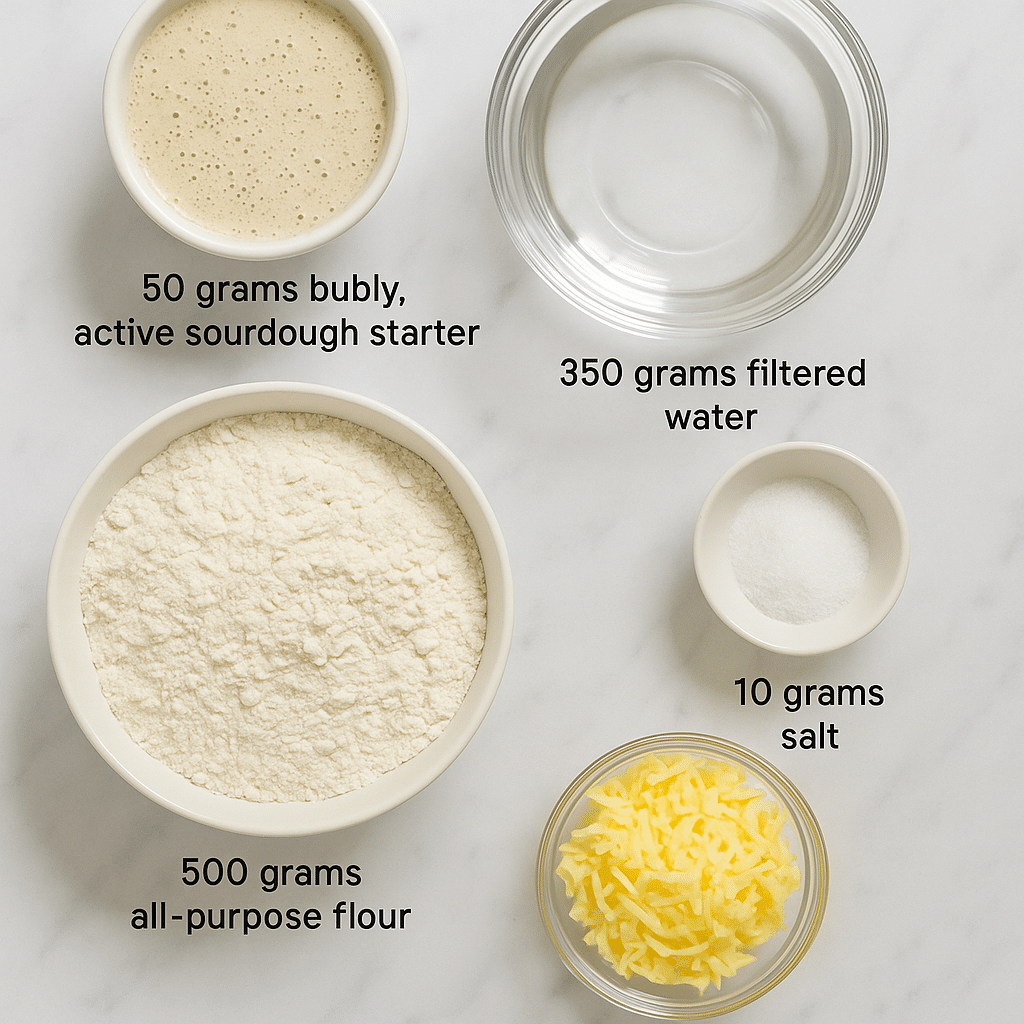
- Essential Ingredients That Make the Dough Work
The secret to a great croissant sourdough loaf recipe lies in simple, quality ingredients. Here’s what you’ll need: - 50g active sourdough starter – bubbly and fed that morning
- 350g filtered water – always go with filtered to protect your culture
- 500g all-purpose flour – unbleached for better fermentation
- 10g salt – regular or sea salt
- ½ cup grated cold butter – salted or unsalted, just keep it cold
You can start this dough in the afternoon once your starter has doubled in size. Begin by mixing the starter and water until it looks milky. Add flour and salt, then mix into a shaggy dough. Cover and let it rest for 45 minutes. Stretch and fold the dough 3–5 times, allowing rest between each set. Let it ferment on the counter overnight—8 to 10 hours—until doubled and airy.
This slow ferment gives your loaf a deep flavor. The result is worth the wait—especially when paired with hot honey popcorn chicken bites or even a savory smear of compound butter.
- Laminating the Dough Without Melting the Butter
Here’s where the magic happens. The next morning, turn the dough onto a lightly floured surface. Gently stretch it into a large rectangle. Grate half the cold butter over the dough. Fold both sides toward the center, then grate more butter before rolling the dough up. Finish by shaping it into a round or oval, depending on your banneton.
Place the dough seam-side-up in the floured banneton, stitch the seam, cover, and refrigerate it for at least 2 hours—or up to 3 days. The cold rest firms the butter and deepens the flavor. It also makes scoring and baking easier, giving your loaf that iconic flake and rise.
- Pro Tip: If you loved my spiced pear bread, you’ll appreciate the fruity variation of adding a thin layer of fig or apricot jam before rolling. Just be sure not to overdo it—too much moisture can weigh the dough down.
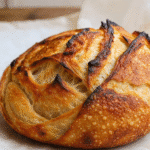
Buttery Layers Meet Tangy Crust – The Ultimate Croissant Sourdough Loaf Recipe
- Total Time: 1 hour 30 minutes
- Yield: 1 loaf 1x
- Diet: Vegetarian
Description
This croissant sourdough loaf recipe gives you the flake of a pastry with the tang of sourdough bread—all in one satisfying bake.
Ingredients
50g active sourdough starter
350g filtered water
500g all-purpose flour
10g salt
½ cup cold butter, grated
Instructions
1. Mix starter and water until milky
2. Add flour and salt, mix to a shaggy dough
3. Rest 45 mins, stretch and fold 4 times
4. Cover and ferment overnight until doubled
5. Next morning, laminate with grated butter
6. Fold and shape into a boule or oval
7. Place in floured banneton, seam up
8. Refrigerate for at least 2 hours
9. Preheat oven with Dutch oven to 475°F
10. Flip loaf onto parchment, score top
11. Bake 20 min covered, 25 min uncovered
12. Cool completely before slicing
Notes
Always use cold butter and chill the dough before and after lamination
Avoid overproofing before baking—watch dough volume, not time
Great with jam or savory toppings like cheese
- Prep Time: 45 minutes
- Cook Time: 45 minutes
- Category: Baking
- Method: Laminated Sourdough
- Cuisine: French-American
Nutrition
- Serving Size: 1 slice
- Calories: 230
- Sugar: 1g
- Sodium: 220mg
- Fat: 9g
- Saturated Fat: 5g
- Unsaturated Fat: 3g
- Trans Fat: 0g
- Carbohydrates: 32g
- Fiber: 2g
- Protein: 6g
- Cholesterol: 20mg
Baking and Troubleshooting Your Croissant Sourdough Loaf Recipe
- From Cold Dough to Golden Flaky Crust
After your dough has chilled and your butter is firm, it’s time to bake. Preheat your oven to 475°F (245°C) with a Dutch oven or combo cooker inside for at least 30 minutes. Carefully flip the dough onto parchment, score the top with a sharp lame or razor, and gently lower it into the hot pot. Bake covered for 20 minutes, then uncover and reduce the heat to 450°F (232°C) for another 25–30 minutes.
When it’s done, your croissant sourdough loaf should be golden brown with a crisp crust. You’ll hear that hollow thump when tapped, and it should smell like a sourdough bakery with a buttery twist. Let it cool on a wire rack for at least an hour before slicing—resist the urge to cut early! This wait helps the steam settle and keeps your loaf from turning gummy.
Serve it up warm with a swipe of butter, or pair it with something savory like my ground beef and gravy over mashed potatoes. You can even toast leftovers and dunk them into soups or stews for a luxurious bite.
- Common Mistakes and How to Fix Them
Even seasoned bakers face a few bumps when making a croissant sourdough loaf recipe. If your butter leaks out, it’s likely your dough or butter was too warm during lamination. Always chill between folds and keep your kitchen as cool as possible.
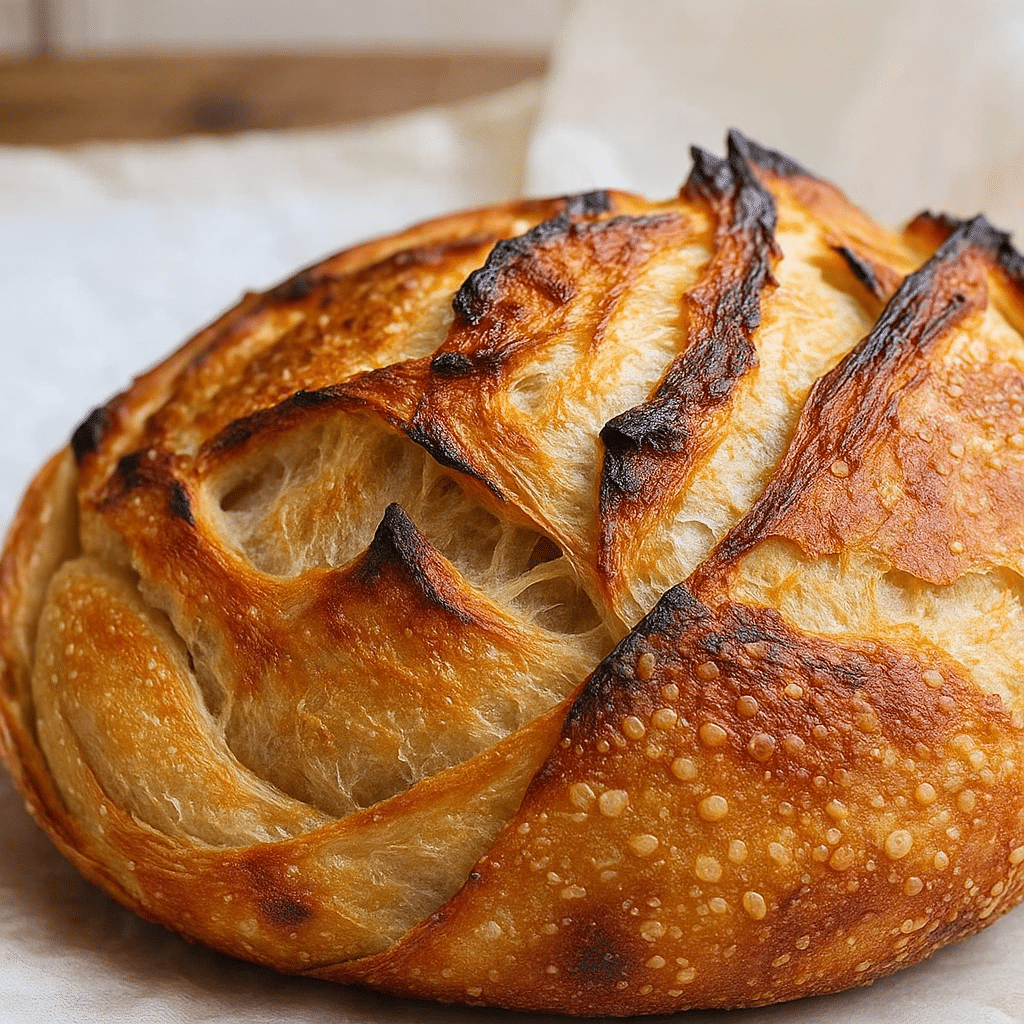
If you don’t get distinct flaky layers, check your folds. Be gentle and deliberate. Don’t overwork the dough or press too hard. It’s better to under-roll than to squash your beautiful butter pockets. A dull knife when scoring can also deflate the loaf—use a fresh blade or bread lame for that clean finish.
Want to test your layering skills before tackling this loaf again? Try something simpler like the cottage cheese banana bread. It’s a great practice recipe that still delivers a gorgeous crumb.
This part of the process might seem intimidating, but with a bit of patience, your croissant sourdough loaf recipe will turn out beautifully flaky and flavorful. The more you bake, the better your intuition becomes.
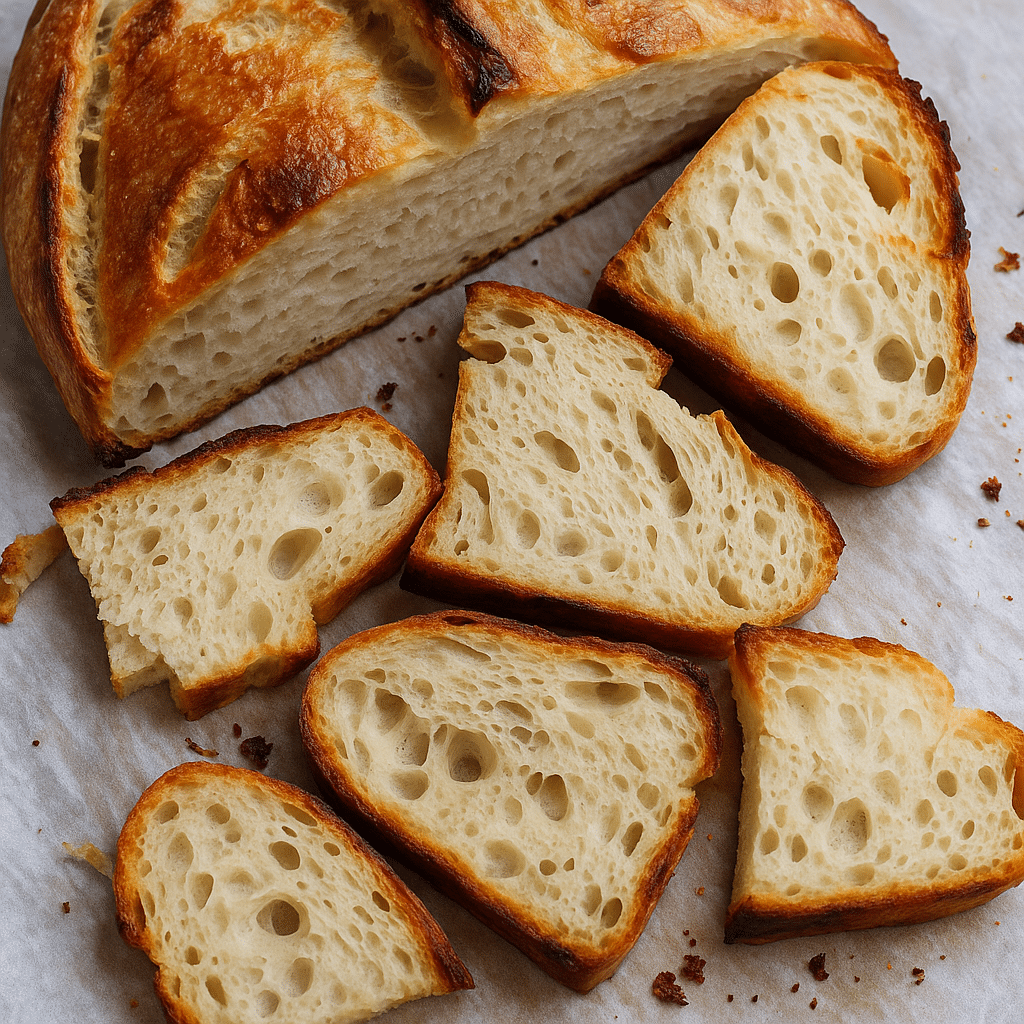
Flavor Variations and How to Store Your Croissant Sourdough Loaf
- Fun Variations to Try With the Same Base Dough
One of the best things about this croissant sourdough loaf recipe is how flexible it is once you master the base. Want a savory version? Try adding shredded cheddar and finely chopped chives during the second butter layer for a bakery-style twist. A few readers even reported success with folding in pesto or sun-dried tomatoes—but be sure to keep additions light to protect the structure.
For a sweet variation, lightly dust the dough with cinnamon sugar or spread a thin layer of fruit preserves before rolling. Just like my strawberry shortcake icebox bars, this small touch adds a lovely burst of flavor without compromising the crumb.
You can also switch up the flour. A 20% mix of whole wheat gives it a hearty, rustic touch without losing those airy layers. Don’t go too high on the whole grains, though, or you’ll weigh down the lamination.
- How to Store It Without Losing That Signature Flake
You’ve made a gorgeous croissant sourdough loaf—but now what? If you’re not eating it all the same day (which honestly happens around here), wrap the fully cooled loaf in parchment and store in a paper bag or bread box. It’ll stay fresh for 2–3 days at room temperature.
To freeze, slice the loaf, place parchment between slices, and store in a freezer-safe bag. When ready to eat, toast from frozen or reheat at 300°F in the oven for 10–12 minutes. It’ll bring the butter back to life and restore some crispness.
This croissant sourdough loaf recipe also makes excellent French toast. Just dip in egg, fry gently, and enjoy with maple syrup. For a fancier breakfast, try pairing it with a drink like mocha iced coffee—the combo is ridiculously good.
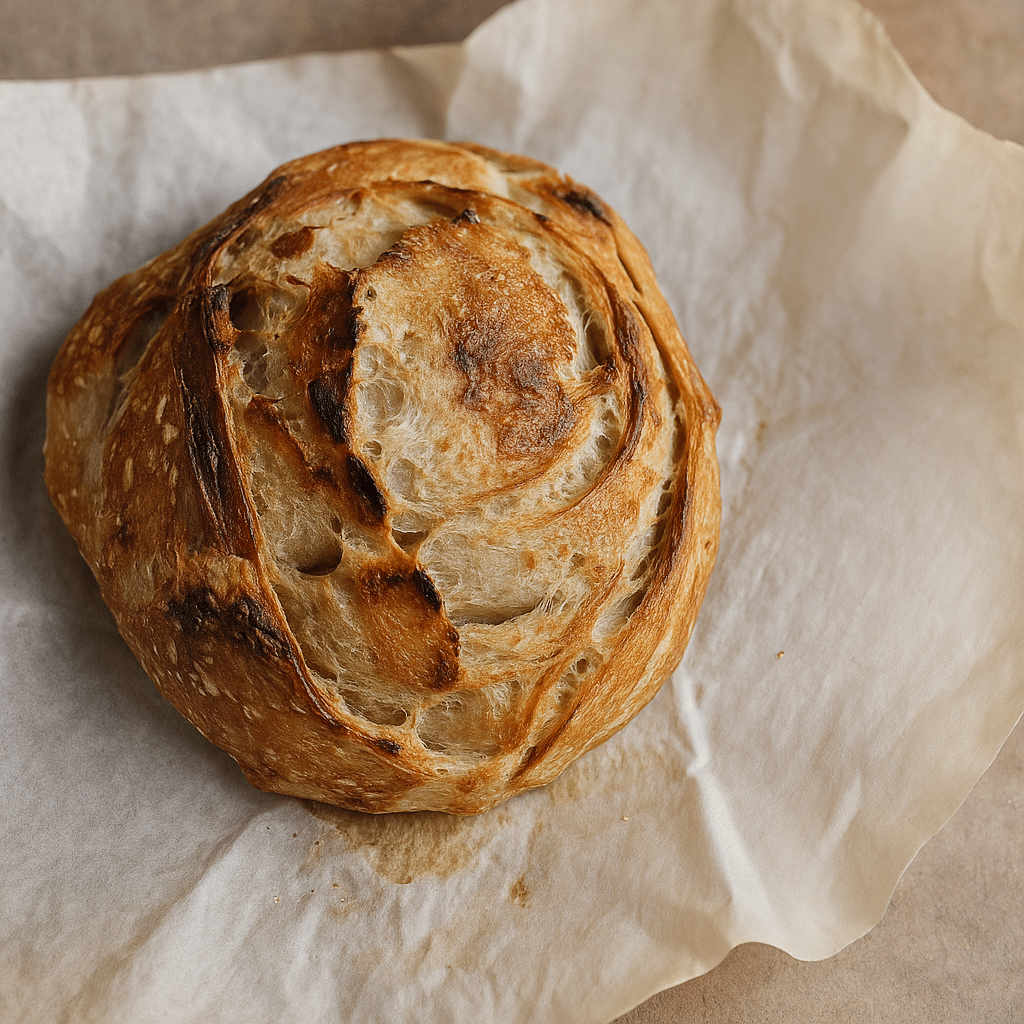
Whether you go sweet, savory, or classic, storing and enjoying this loaf is just as satisfying as baking it.
Frequently Asked Questions + Final Thoughts
What is a sourdough croissant loaf?
A sourdough croissant loaf is a hybrid bake that combines the tangy chew of sourdough bread with the buttery, flaky texture of croissants. It uses lamination—layering cold butter into the dough—to create airy pockets and a golden crust. If you’ve tried chewy vegan monster cookies, this loaf gives you a similar mix of soft inside and crisp outside—just in bread form.
Can you laminate sourdough like croissant dough?
Yes, you absolutely can! In this croissant sourdough loaf recipe, lamination works beautifully because the dough is hydrated and elastic. The trick is keeping your butter cold and handling the dough with care. It’s not as delicate as puff pastry, so it’s actually more forgiving—great news if this is your first laminated bake.
Why does butter leak when baking sourdough croissant bread?
Butter leakage usually happens when the dough or butter gets too warm. For this croissant sourdough loaf recipe, always chill the dough between folds and avoid overhandling. Use grated or slabbed butter, and try working in a cool room if possible. Baking in a preheated Dutch oven helps trap steam and set the loaf quickly, sealing the layers before they melt.
How do you get flaky layers in a sourdough croissant loaf?
The flake factor comes from proper folding, resting, and scoring. You’ll want to roll and fold the dough just enough to create layers, not knead it. Letting it chill after shaping is key—just like when making fruit and ricotta cake, rest time enhances flavor and texture.
Conclusion: Why This Croissant Sourdough Loaf Recipe Is Worth Repeating
Making a croissant sourdough loaf recipe might sound fancy, but it’s a lot like any good kitchen memory—it starts with a little curiosity and ends with something warm, buttery, and full of heart. Every slice is a reward, not just for your effort, but for your patience. You’ll taste the tang of slow fermentation and the comfort of flaky pastry in every bite.
Whether you pair it with jam and coffee or tuck it next to a hearty stew, this recipe delivers. It’s not just bread—it’s a bake that tells a story. Try it once, and it might just earn a regular spot in your kitchen rotation.
Want more cozy bakes and real kitchen stories? Follow me on Pinterest for sourdough favorites and on Medium for behind-the-recipe reflections that don’t always make it to the blog.





